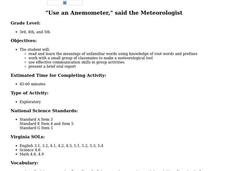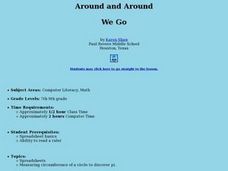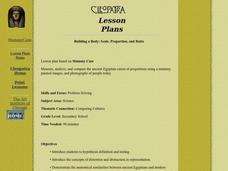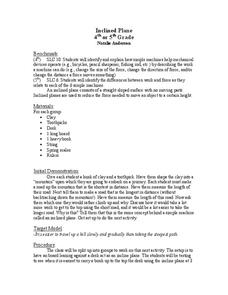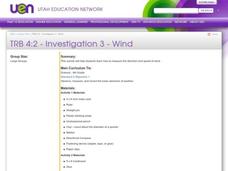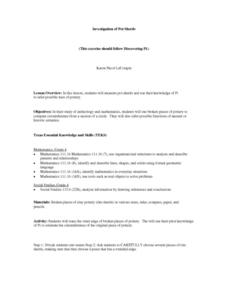Curated OER
Escape! Survival of the Fittest Grasshopper
Fourth graders, in groups, design a paperclip grasshopper. They determine its ability to survive a prey by jumping high, far, or with a distracting behavior.
Curated OER
Million Dollar Gift
Third graders create a box big enough to hold a million dollars. This is a project fun to do near the winter holidays with inexpensive gifts included in the boxes. This hands-on lesson very effectively demonstrates the concept of volume.
Curated OER
Conservation Station
Second graders, in groups, measure the volume of four containers that vary in shape and size.
Curated OER
"Use an Anemometer," said the Meteorologist
Students work in groups to make an instrument the Meteorologists use to measure the speed of the wind after the teacher reads them a poem about the wind. Students then review vocabulary that they studied from their lesson.
Curated OER
Around and Around
Students create a spreadsheet to record information about circular objects. They measure and record information from a variety of objects. Students calculate the ratio of the circumference to the diameter of each object. They find the...
Curated OER
Estimating Area
Fifth graders, after being given a variety of word problems to solve, find patterns to solving 3 out of 4 times. They break it down into smaller parts 3 out of 4 times and tell the method of solving 3 out of 4 times. Students complete...
Curated OER
Math: Arcs and Chords
Students draw diagrams demonstrating how it is possible to two central angles to be congruent and their minor arcs are not congruent. In groups, they illustrate theorems with their constructed circles, create diameters of circles that...
Curated OER
Just a Little Bit
Second graders read the book, "Just a Little Bit" and work in groups weighing the same object with a scale. They then get a different unit of measurement, like paper clips, cotton balls, washers, or pennies and then figure out and record...
Curated OER
Building a Body: Scale, Proportion, and Ratio
Students measure, analyze, and compare the ancient Egyptian canon of proportions using a mummy, painted images, and photographs of people today.
Curated OER
Let's Weigh Air
Students participate in an experiment to measure the weight of air by measuring the weight of the mass it displaces. They lift up a desk and a textbook using a toilet plunger, and calculate the weight of the air, or air pressure.
Curated OER
What's the Attraction?
Learners experiment with magnets to determine the distances at which they attract and repel each other.
Curated OER
A Visit to Southern Africa - Volcano
Students examine a cookie that represents pumice and lava in order to realize that lava is a composite of many rock particles. They compare and contrast pumice to the cookie by estimating, weighing, measuring and dissecting the cookie...
Curated OER
A Cosmic Cafeteria
Students indentify and differentiate between transit and surface food systems. Students measure energy that is released by various foods. Students compare and contrast cooking with solar energy on earth and what they might have learned...
Curated OER
The Derivation of (Pi)
Seventh graders groups measure the diameter and circumference of each of the circular objects in the room. They record their results on their student worksheets and access a computer spreadsheet program to compile their results.
Curated OER
Inclined Plane
Students using clay and a toothpick, shape the clay into a "mountain" upon which they make a road that is the shortest in distance. They measure the length of their road and then make a road that is the longest in distance without...
Curated OER
Wind
Fourth graders are read a story and answer the comprehension questions about sound and wind. In groups, they make their own wind vane and how to determine the direction of the wind. To end the lesson, they make their own Anemometer to...
Curated OER
Investigation of Pot Sherds
Fourth graders review their prior knowledge on the concept of pi. Using broken pieces of pottery, they calculate the circumference from a section of the circle. In teams, they compete against one another to get the most accurate...
Curated OER
Stream Chemistry Monitoring
Students become familiar with real-world gathering of chemical data. The experience how the science is done: the nature of analysis, data collection, interpretation, and presentation. They study a nearby body of water for their experiment.
Curated OER
How Fast Does This Tree Grow?
Students work together to determine how fast trees go. They make predictions and complete simple measurements. They answer questions to end the lesson.
Curated OER
Spatial Characterization of Animal Movement
Learners identify biotic and abiotic factors which may alter the observed patterns in plant communities with different structural characteristics, climate, or environmental constraints.
Curated OER
C.D. Cover
Students use computers to create CD covers for their music groups. They search online for images they associate with their local reality, practice manipulating them in photo-editing program, measure size of compact disc case, and create...
Curated OER
What a Site!
Fourth graders are introduced to how to properly create a grid site. In groups, they use Cartesian coordinates to establish the boundaries for the grid and photograph the location of artifacts. They exchange their photos with another...
Curated OER
How Many? How Far? How Thick?
Fifth graders examine the role of magnetism and electricity. In groups, they are given different types of magnets and discover how the magnetic force differs for each one. They measure the amount of distance a paper clip moves toward...
Curated OER
Water & Ice
Learners investigate the properties of water. In this states of water lesson, students explore how water goes from liquid to solid and back to liquid again. Learners use measurement, observation, and communication to describe the change.



